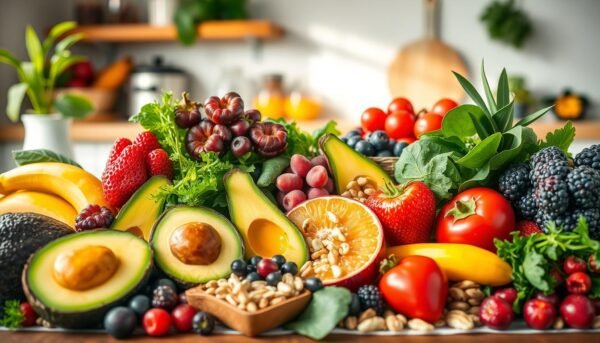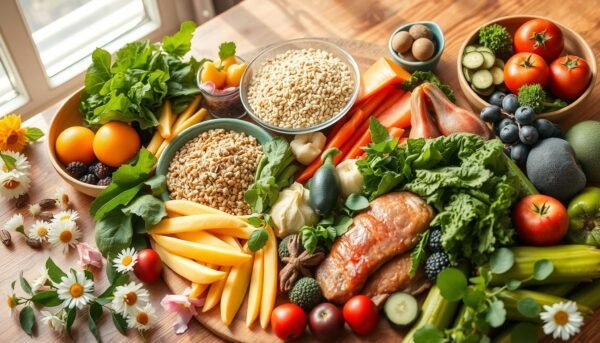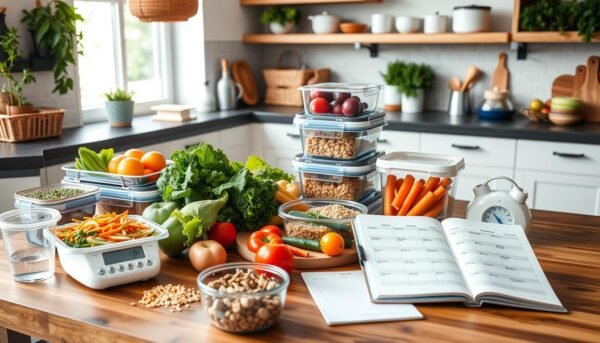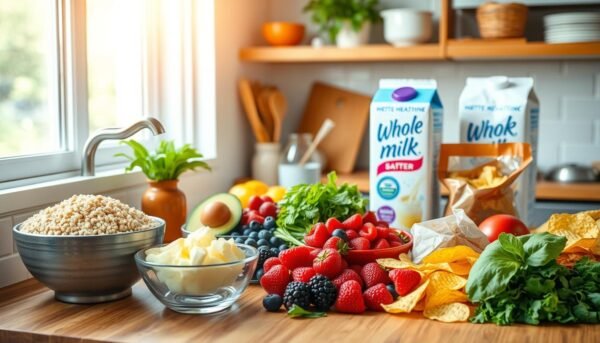I’ve been on the rollercoaster of fad diets and unhealthy eating. It’s tough to keep a balanced diet. We often chase unrealistic weight loss goals, leading to bad diets and a negative food relationship. But there’s a better way.
In this guide, we’ll find ways to avoid bad diets and enjoy healthy eating. We’ll talk about smart shopping and mindful eating. These topics will help you on your health and wellness journey.
If you want to manage your weight, boost energy, or live healthier, this article is for you. We’ll explore diets for women together. Let’s learn to nourish our bodies and minds with a balanced diet.
Understanding the Impact of Unhealthy Eating Patterns on Women’s Health

Nutrition is key for women’s health and happiness. Many women face unhealthy eating habits that harm them. It’s vital to know how bad diet choices affect women’s needs.
Common Health Issues from Poor Diet Choices
Poor nutrition can cause heart disease, obesity, and type 2 diabetes in women. Diets missing important nutrients can harm long-term health. Eating too much processed, fatty, and sugary food raises the risk of chronic diseases that hit women hard.
Mental and Physical Effects of Restrictive Dieting
Restrictive dieting often fails to meet women’s body image goals. It can lead to mental and physical problems. These include nutrient deficiencies, irregular periods, and eating disorders. Cutting calories too much can slow down metabolism, causing a cycle of weight gain and loss.
How Stress Affects Women’s Eating Habits
Stress greatly affects women’s eating. Up to 40% of women worldwide face chronic stress. This stress can lead to emotional eating or skipping meals, worsening nutritional imbalances and health problems.
Knowing how bad diet choices, restrictive dieting, and stress harm women’s health is crucial. We can then work on better nutrition plans for women. This promotes healthy eating and fitness for women.
Smart Grocery Shopping Strategies for Balanced Nutrition

Starting a balanced diet for women begins with smart grocery shopping. Plan ahead and choose wisely at the supermarket. This way, you can fill your kitchen with foods that boost your health and wellness.
First, make a shopping list before you go. Focus on whole, unprocessed foods like fresh veggies, lean proteins, and whole grains. Don’t shop when you’re hungry. This can lead to buying unhealthy snacks.
When shopping, pick foods rich in nutrients. Choose seasonal, local produce for freshness and savings. Canned or frozen fruits and veggies are also good for your wallet and health. Look for lean proteins like chicken, fish, eggs, and tofu.
| Affordable Protein Sources | Nutrition Information |
|---|---|
| Chicken Thighs | Affordable and flavorful, with slightly higher fat content than breast |
| Eggs | Versatile, economical, and packed with high-quality protein |
| Canned Beans | Convenient and budget-friendly plant-based protein |
| Tofu | Versatile, affordable, and a great source of plant-based protein |
Choose whole-grain options like brown rice and quinoa over refined grains. These provide energy and fiber, keeping you full.
Also, buy healthy fats like avocados and olive oil. These foods are rich in nutrients and support your health.
By using these smart shopping tips, you can get the right foods for a balanced diet. Focus on whole foods to nourish your body and support your active lifestyle.
Essential Nutrients and Food Groups for Women’s Wellness

Women have different dietary needs than men. It’s important to know the key nutrients and food groups for our health. Eating a balanced diet helps our bodies stay healthy and strong.
Importance of Protein and Iron Sources
Protein helps keep muscles strong and makes us feel full. Women should eat lean meats, fish, eggs, and plant-based options like legumes and tofu. Iron is key for menstruating women to replace lost iron. Include iron-rich foods like spinach, lean red meat, lentils, and fortified cereals in your meals.
Calcium-Rich Foods for Bone Health
Calcium and vitamin D are crucial for strong bones, especially as we get older. Eat dairy products, leafy greens, and fortified foods to get enough calcium. Also, weight-bearing exercises help keep bones strong and prevent osteoporosis.
Vital Vitamins and Minerals
Women need various vitamins and minerals, like omega-3 fatty acids, folate, and B-vitamins. Eating a variety of fruits, vegetables, whole grains, and healthy fats helps meet these needs.
By focusing on these nutrients and food groups, women can keep their bodies healthy. This supports their overall wellness and meets their unique health needs.
| Nutrient | Importance for Women | Food Sources |
|---|---|---|
| Protein | Muscle maintenance, satiety | Lean meats, fish, eggs, legumes, tofu |
| Iron | Replace iron lost during menstruation | Spinach, lean red meat, lentils, fortified cereals |
| Calcium | Bone health | Dairy products, leafy greens, fortified foods |
| Omega-3s | Brain and heart health | Fatty fish, flaxseeds, walnuts, chia seeds |
| Folate | Prevent neural tube defects in pregnancy | Leafy greens, citrus fruits, fortified cereals |
| B-Vitamins | Energy production, red blood cell formation | Whole grains, poultry, eggs, leafy greens |
Meal Planning and Portion Control Techniques

Starting a healthy diet is all about meal planning and portion control. For women looking to lose weight and feel better, these tips are key. Planning meals ahead ensures you eat well all week and avoid bad eating habits.
Using smaller plates is a smart move. Studies show big plates make us eat more. Smaller plates help you eat less and feel full faster.
Mindful eating is crucial for controlling portions. Eat slowly and listen to your body’s hunger signals. Eating fast can lead to weight gain and health issues. Enjoying your food slowly helps you stop when you’re full.
Cooking at home is a big plus for female-friendly meal plans and weight loss for females. You control what goes into your meals and how much. This way, you make healthier choices.
Try new recipes every week to keep your diet interesting. This keeps your taste buds happy and ensures you get all the nutrients you need.
Using a food scale or measuring cups helps track your portions. Reading labels and keeping a food diary also helps you understand what you eat.
Adopting these meal planning and portion control tips can help you reach your health goals. Remember, small steps lead to big changes. Be patient and kind to yourself on your journey.
Diets for Women: Finding a Sustainable Approach

When looking for diets for women, the goal is to find something you can keep up with. Fad diets might work for a short time but are hard to stick with. They can also harm your health.
Identifying Healthy vs. Fad Diets
Good diets focus on long-term health, not quick fixes. Look for plans that include lots of healthy foods and are flexible. Avoid diets that cut out whole food groups or promise too much weight loss too fast.
Creating Realistic Eating Goals
Set goals that are easy to reach, not too high. Experts say losing 1 to 2 pounds a week is safe and doable. Think about your life, likes, and health when setting goals.
Good diets should be fun and let you have treats now and then. Eating nutrient-rich foods and building healthy habits can lead to lasting results. This improves your health and happiness.
The secret to keeping weight off is not about fast fixes or extreme diets. It’s about finding a healthy, balanced way to eat that you can keep up for years.
Mindful Eating Practices for Better Health

Adding mindful eating to your daily life can change your nutrition for women’s health and women’s fitness nutrition. It means eating with full attention, stopping overeating, and improving digestion.
Slow down is a big part of mindful eating. Enjoy each bite, noticing the tastes, textures, and how it feels. Don’t watch TV or do other things while eating. Listen to when you’re hungry or full. This can cut down on eating when stressed and make you feel better about food.
- Eat slowly and without distractions
- Focus on the flavors, textures, and sensations of your food
- Listen to your body’s hunger and fullness signals
Mindful eating can also make you choose better foods and enjoy your meals more. It helps you listen to what your body needs. Plus, eating slowly lets your brain catch up with your body, stopping you from eating too much.
Adding mindful eating to your daily routine can greatly improve your nutrition for women’s health and well-being. So, when you eat, breathe deeply and use all your senses. This way, you truly nourish your body and mind.
Hydration and Its Role in Women’s Nutrition

Drinking enough water is key for a healthy diet in women. It helps with weight, energy, and health. Knowing how much water to drink and trying other healthy drinks can help meet dietary needs.
Water Intake Guidelines
The amount of water women should drink daily changes with age, activity, and health. Generally, women need about 2.7 liters (11.5 cups) of fluids each day. This can be water, herbal teas, and foods with lots of water like fruits and veggies.
Healthy Beverage Alternatives
- Water: Plain, filtered water is the best choice for hydration, as it contains no calories or added sugars.
- Herbal teas: Unsweetened herbal teas can provide a flavorful alternative to water and offer potential health benefits.
- Low-fat or fat-free milk: Dairy products like milk are a good source of calcium and other essential nutrients.
- Unsweetened plant-based milk alternatives: Soy, almond, or oat milk can be a lactose-free option.
- 100% fruit or vegetable juices: These beverages can contribute to overall fluid intake, but they may also be high in natural sugars.
- Sparkling water: Carbonated water with natural flavors can provide a refreshing, low-calorie alternative to sugary sodas.
It’s best to drink less of sugary drinks like regular sodas and sweetened coffee or tea. They can add too many calories and don’t hydrate as well as water.
| Beverage | Nutritional Considerations |
|---|---|
| Water | Calorie-free, essential for hydration and bodily functions |
| Herbal Tea | Calorie-free, can provide antioxidants and other health benefits |
| Low-fat Milk | Good source of calcium and other nutrients, may contribute to satiety |
| Unsweetened Plant-based Milk | Lactose-free, lower in calories than dairy milk, may provide additional nutrients |
| 100% Fruit/Vegetable Juice | Provides vitamins and minerals, but also natural sugars |
| Sparkling Water | Calorie-free, can provide a refreshing alternative to sugary drinks |
By focusing on water and trying different healthy drinks, women can meet their hydration needs. This supports their health and well-being.
Healthy Food Swaps and Kitchen Makeover Tips

Making small changes to your diet can greatly improve your health. Consider these smart food swaps and kitchen tips for a healthier diet.
Start with drinks. Ditch sugary sodas and juices for water or unsweetened options like seltzer water, herbal tea, or low-fat milk. These choices help you stay hydrated and cut down on sugar.
Choose whole-grain foods over refined ones. Whole grains like brown rice, quinoa, and oats are packed with fiber, vitamins, and minerals. For instance, whole wheat pasta has four times more fiber than white pasta.
For protein, go for lean meats, fish, beans, lentils, and plant-based options like tofu or tempeh. These foods support muscle health and help with weight management.
- Swap sour cream for plain Greek yogurt, which is higher in protein and lower in fat.
- Use avocado instead of mayonnaise for creaminess and healthy fats.
- Replace white flour with whole wheat flour in baked goods for more fiber and nutrients.
Also, clean out your kitchen and get rid of processed foods high in sugar, unhealthy fats, and sodium. Add healthier snacks like nuts, seeds, and fresh fruits and vegetables. Meal prepping can also cut down on waste and keep you eating well.
By making these easy changes, you can make your kitchen a healthier place. Small steps can lead to big improvements in your diet and overall health.
Building Healthy Habits for Long-Term Success
Starting healthy habits is key for lasting success in eating well. Wake up 30 minutes early for exercise or meal prep. Add regular physical activity, like short walks, to your day.
Make sleep a priority, aiming for 7-9 hours a night. This helps with your fitness and weight loss goals.
Watch your hormones and menstrual cycle to understand their impact on your health. Focus on one task at a time to lower stress. Spend time outdoors to boost vitamin D and well-being.
Small, steady changes are the way to lasting results in diet plans for women. Be patient with yourself as you build new habits.
Think about the good changes you’ve made, like eating more veggies or choosing low-fat dairy. Use apps like Healthi to track your progress and connect with others. With commitment and balance, you can achieve long-term success in your fitness and nutrition journey.
This post may contain affiliate links which means I may receive a commission for purchases made through links. I will only recommend products that I have personally used! Learn more on my Private Policy page.